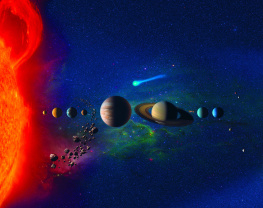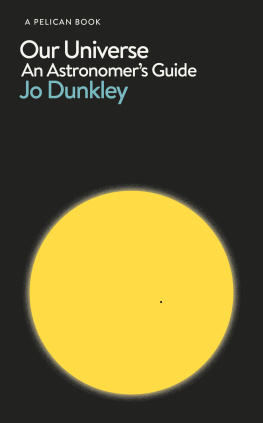
TIME
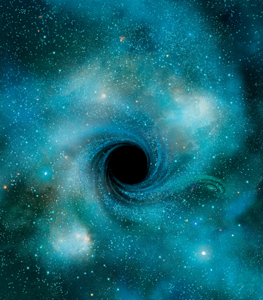
THE SEARCH FOR LIFE IN THE UNIVERSE
Contents
- Triumph of the Planet Hunters
The search for other worlds is coming up roses - Something in the Air Up There
Astronomers use a bag of tricks to detect exoplanets - E.T., Are You Calling Us?
The search for extraterrestrial life could use a boost - SETI Warriors
Looking for aliens is just another day at the office - Spies of the Sky
Powerful new telescopes are spilling cosmic secrets - Neighborhood Watch
Looking for life in our own solar system - Discovery Channels
Highlights from more than a half-century in space - Life As We Dont Know It
Recognizing alien life-forms may not be easy - Aliens Among Us
Do comets and meteorites seed the cosmos with life? - Extremophiles
Life thrives in the most inhospitable places - Whats a Nice Alien Like You... ?
If an ET arrives, will we roll out the welcome mat? - Why We Believe
We use aliens to fill some very human needs - My Favorite Aliens
A cavalcade of space creatures, wacky to woeful - Maybe We Are the Only Ones
The existential bummer of finding nothing
Parts of this book were previously published in TIMEs New Space Discoveries and in TIME magazine .
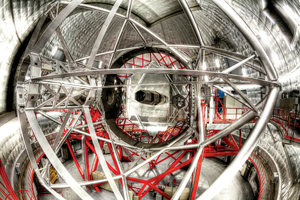
THE GREAT CANARY TELESCOPE , which began scientific observations in 2009 in the Canary Islands, is the worlds largest single-mirror optical telescope.
Triumph of the Planet Hunters
Recent discoveries suggest that our galaxy contains billions of Earth-size worlds. Now astronomers are narrowing the searchfor planets that most closely resemble ours in the particular ways that support life
BY MICHAEL D. LEMONICK

BESIDE A MODEL of the Kepler spacecraft at NASAs Ames Research Center, William Borucki, the missions chief scientist, lectures on the space observatory, which orbits the sun in search of distant Earth-like planets.
LOOK UP ON A CLEAR, MOONLESS night, far from city lights, and you can see thousands of stars twinkling in the dark vault of the sky. Astronomers, of course, will assure you that the stars arent really twinkling. Rather, its an illusion caused by the shimmering of Earths atmosphere, something like the rippling air you see coming off the hood of a car on a hot summer day.
In fact, many stars are twinkling, if only in a way that a clear-eyed telescope orbiting high above the atmosphere can make out. More precisely, the stars are winking at us, dimming just a bit on a schedule as precise as clockwork. Others are wobbling in place, moving toward us and away, then back again with the same sort of rhythm.
The explanation for all this winking and wobbling is that most stars arent drifting through the Milky Way in solitude. Theyre accompanied by planets, just as the sun is; those winks and wobbles are proof of that. When a planet passes precisely in front of its star from Earths point of view, the star dims subtly. Even when things arent lined up quite so perfectly, the planets gravity tugs the star to and fro as it orbits, causing measurable changes in starlight.
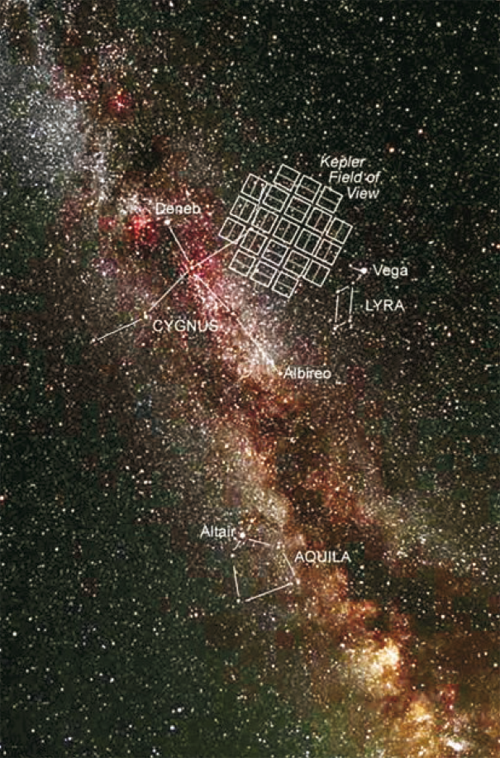
KEPLER TAKES AIM at the Milky Way. Each rectangle indicates a specific target region covered by one of the 42 paired photographic CCD elements.
By noting the winks and wobbles with exacting precision, astronomers have found thousands of alien worlds, called exoplanets, in an almost bewildering variety of sizes and orbits, since the first was discovered just two decades ago. As yet, none truly resemble our Eartha world of similar size, orbiting at just the right distance from its star, so its temperature is neither too hot nor too cold to harbor life.
Astronomers are on the verge of finding one, though, and given how short a time they have been in the planet-hunting business, when they do, it will be an extraordinary achievement. They discovered the first planet orbiting a sunlike star in 1995, when I was in college, says Eric Ford, an astronomer at Penn State, and now I get to help search for the first Earth-like planets. Thats pretty cool.
It could also be transformative. Since ancient Greece at least, philosophers have argued the question of whether we are alone in the cosmos. While finding a second Earth wont end that debate right away, it will take astrobiologists working at the intersection of astronomy and biology a big step closer by giving them somewhere to look.
FOR YEARS, THE ODDS-ON FAVORITE to make such a discovery was the Kepler mission, a telescope whose sole function since its 2009 launch was to stare ceaselessly at a field of some 156,000 stars located in the northern sky between the constellations Cygnus and Lyra, waiting for any to wink as a planet passes by. The project was developed by Bill Borucki at the NASA Ames Research Center in California (and was rejected four times before NASA finally gave it the go-ahead). Borucki reasoned that if you focus on just one star hoping a planet will pass it, youll almost certainly fail, as planet and star have to line up just right for the event to be visible. Look at many tens of thousands, however, and youre a lot more likely to catch a planet in the act.
Kepler has succeeded, spectacularly. At last count it had discovered more than 4,000 planet candidates, and follow-up observations have confirmed nearly a quarter of them as bona fide planets. Still, true twins of Earth remain elusive. While Kepler identified more than 100 Earth-size planets, virtually all of them are too hot for life as we know it. Then again, extrapolating from what Kepler has seen in that small patch of sky, there could be as many as 40 billion Earths in the Milky Way alonewith the nearest no more than 12 light-years away. Of the current search field, Harvards Courtney Dressing, who made the calculation, says, Statistically speaking, this is like a stroll across the park.
Kepler also revealed the existence of a class of worlds that doesnt exist in our own solar system: super-Earths, which lie in size midway between Earth and Neptune. Its not yet clear whether these tend to more closely resemble Earthmostly rock, with a relatively thin atmosphereor Neptune, whose rocky core is surrounded by a deep shroud of gas. In all likelihood, says Andrew Howard of the University of Hawaii, the answer is both: There are a lot of ways to make a planet twice the size of Earth, Howard says. For me, its kind of amazing that we keep expecting planetary systems like our own, and they keep turning out to be different.

Kepler 11s six planets orbiting their sun

Kepler 22b, the first planet found to orbit the habitable zone, where water can exist
Next page






